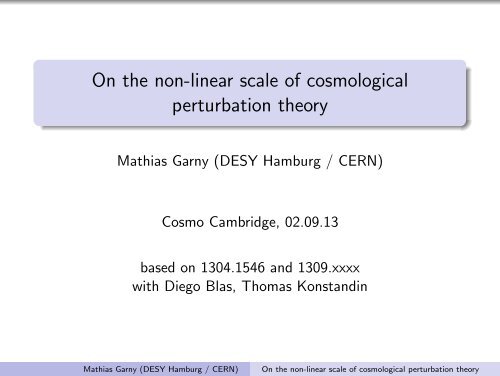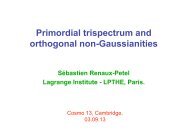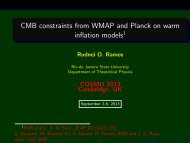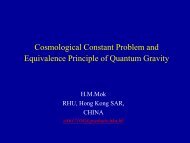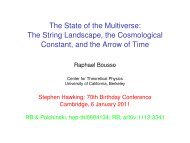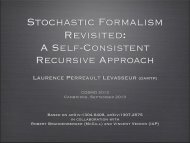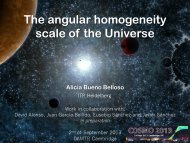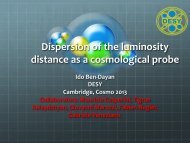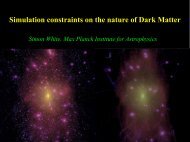On the non-linear scale of cosmological perturbation theory
On the non-linear scale of cosmological perturbation theory
On the non-linear scale of cosmological perturbation theory
- No tags were found...
Create successful ePaper yourself
Turn your PDF publications into a flip-book with our unique Google optimized e-Paper software.
<strong>On</strong> <strong>the</strong> <strong>non</strong>-<strong>linear</strong> <strong>scale</strong> <strong>of</strong> <strong>cosmological</strong><strong>perturbation</strong> <strong>the</strong>oryMathias Garny (DESY Hamburg / CERN)Cosmo Cambridge, 02.09.13based on 1304.1546 and 1309.xxxxwith Diego Blas, Thomas KonstandinMathias Garny (DESY Hamburg / CERN)<strong>On</strong> <strong>the</strong> <strong>non</strong>-<strong>linear</strong> <strong>scale</strong> <strong>of</strong> <strong>cosmological</strong> <strong>perturbation</strong> <strong>the</strong>ory
OutlineStandard Perturbation TheoryThree loop resultPadé resummationPadé improved PTMathias Garny (DESY Hamburg / CERN)<strong>On</strong> <strong>the</strong> <strong>non</strong>-<strong>linear</strong> <strong>scale</strong> <strong>of</strong> <strong>cosmological</strong> <strong>perturbation</strong> <strong>the</strong>ory
Standard Perturbation TheoryPoisson/Euler/Continuity eq. for density contrast δ = ρ/¯ρ − 1 and pec.velocity (neglect vorticity/viscosity → talks by Mercolli, Zaldarriaga)Expand solution in δ 0(k) = δ(k, z 0 ∼ 10 3 ), for EdS / growing modeδ(k, z) =∞∑(D +(z))∫q n δ (3) (k − ∑ q i )F n(q 1, . . . , q n)δ 0(q 1) · · · δ 0(q n)in=1= D +(z)δ 0(k) + . . .( )e.g. F2 s (q 1, q 2) = 5 + 1 q 1·q 2 q17 2 q 1 q 2 q 2+ q 2q 1+ 2 (q 1·q 2 ) 27 q1 2q2 2Mathias Garny (DESY Hamburg / CERN)<strong>On</strong> <strong>the</strong> <strong>non</strong>-<strong>linear</strong> <strong>scale</strong> <strong>of</strong> <strong>cosmological</strong> <strong>perturbation</strong> <strong>the</strong>ory
Standard Perturbation TheoryPoisson/Euler/Continuity eq. for density contrast δ = ρ/¯ρ − 1 and pec.velocity (neglect vorticity/viscosity → talks by Mercolli, Zaldarriaga)Expand solution in δ 0(k) = δ(k, z 0 ∼ 10 3 ), for EdS / growing modeδ(k, z) =∞∑(D +(z))∫q n δ (3) (k − ∑ q i )F n(q 1, . . . , q n)δ 0(q 1) · · · δ 0(q n)in=1= D +(z)δ 0(k) + . . .( )e.g. F2 s (q 1, q 2) = 5 + 1 q 1·q 2 q17 2 q 1 q 2 q 2+ q 2q 1+ 2 (q 1·q 2 ) 27 q1 2q2 2Power spectrum 〈δ(k, z)δ(k ′ , z)〉 = δ (3) (k + k ′ )P(k, z) is obtained usingWick <strong>the</strong>orem in terms <strong>of</strong> P 0(q) = P(q, z 0) for Gaussian ICP(k, z) =P 1−loopP lin{ }} { { }} {D +(z) 2 P 0(k) + D +(z) 4 (2P 13 + P 22)+ D +(z) 6 (2P 15 + 2P 24 + P 33) + . . .e.g. P 22(k) = 2 ∫ d 3 q F s 2 (q, k − q) 2 P 0(q)P 0(|k − q|)Mathias Garny (DESY Hamburg / CERN)<strong>On</strong> <strong>the</strong> <strong>non</strong>-<strong>linear</strong> <strong>scale</strong> <strong>of</strong> <strong>cosmological</strong> <strong>perturbation</strong> <strong>the</strong>ory
Standard Perturbation Theory100Plin1-loop2-loopP(k,z=0) [(h/Mpc) -3 ]1010.10.010.001 0.01 0.1 1 10k [h/Mpc]SPT breaks down at small <strong>scale</strong>s / late times [P L−loop ∝ D 2L+2+ ∼ ( 11+z) 2L+2]initial spectrum from CAMB (ΛCDM - WMAP5)Mathias Garny (DESY Hamburg / CERN)<strong>On</strong> <strong>the</strong> <strong>non</strong>-<strong>linear</strong> <strong>scale</strong> <strong>of</strong> <strong>cosmological</strong> <strong>perturbation</strong> <strong>the</strong>ory
Standard Perturbation TheoryMany approaches have been developed to improve behaviour at large k(closure, LPT, RPT, eikonal, ...) see e.g. Carlson, White, Padmanabhan 0905.0479Enhanced contributions (∝ k 2n , n ≤ L) related to interaction with s<strong>of</strong>tmodes cancel out completely in equal-time correlators (like <strong>the</strong> PS), asexpected from Galilean invariancesee e.g. Bertschinger, Jain 95; Frieman, Scoccimarro 95; Anselmi, Pietroni 12; Pietroni, Peloso 13;Sugiyama, Futamase 13; Blas, MG, Konstandin 13; Carrasco, Foreman, Green, Senatore 13; . . .Mathias Garny (DESY Hamburg / CERN)<strong>On</strong> <strong>the</strong> <strong>non</strong>-<strong>linear</strong> <strong>scale</strong> <strong>of</strong> <strong>cosmological</strong> <strong>perturbation</strong> <strong>the</strong>ory
Standard Perturbation TheoryMany approaches have been developed to improve behaviour at large k(closure, LPT, RPT, eikonal, ...) see e.g. Carlson, White, Padmanabhan 0905.0479Enhanced contributions (∝ k 2n , n ≤ L) related to interaction with s<strong>of</strong>tmodes cancel out completely in equal-time correlators (like <strong>the</strong> PS), asexpected from Galilean invariancesee e.g. Bertschinger, Jain 95; Frieman, Scoccimarro 95; Anselmi, Pietroni 12; Pietroni, Peloso 13;Sugiyama, Futamase 13; Blas, MG, Konstandin 13; Carrasco, Foreman, Green, Senatore 13; . . .⇒ RPT ‘as good as’ SPT for large-k for equal-time correlators (but veryuseful for unequal-time corr. as e.g. propagator) e.g. Sugiyama, Spergel 13Cancellations (leading + sub-leading terms) can be made manifest forloop integrand⇒ crucial for Monte-Carlo integrationBlas, MG, Konstandin 13; Carrasco, Foreman, Green, Senatore 13Mathias Garny (DESY Hamburg / CERN)<strong>On</strong> <strong>the</strong> <strong>non</strong>-<strong>linear</strong> <strong>scale</strong> <strong>of</strong> <strong>cosmological</strong> <strong>perturbation</strong> <strong>the</strong>ory
Three loop100Plin1-loop2-loop3-loop k ref =k3-loop log measureP(k,z=0) [(h/Mpc) -3 ]1010.10.010.001 0.01 0.1 1 10k [h/Mpc]Diego Blas, MG, Thomas Konstandin 1309.xxxx (power spectrum); see also Bernardeau, Taruya, Nishimichi,1211.1571 (propagator)Mathias Garny (DESY Hamburg / CERN)<strong>On</strong> <strong>the</strong> <strong>non</strong>-<strong>linear</strong> <strong>scale</strong> <strong>of</strong> <strong>cosmological</strong> <strong>perturbation</strong> <strong>the</strong>ory
Loop expansion <strong>of</strong> PS in <strong>the</strong> limit <strong>of</strong> small kFor small k Fry AJ421 (1994) 21P L−loop (k, z) →(2L + 1)!2 L−1 L!∫ ∫P lin (k, z) · · · F2L+1(k, s q 1, −q 1, . . . , q L , −q L )q 1 q L× P lin (q 1, z) · · · P lin (q L , z)Using property F s 2L+1 ∝ k 2 for k ≪ q i Gor<strong>of</strong>f, Grinstein, Rey, Wise AJ311 (1986) 6P L−loop (k, z) ∝ k 2 P lin (k, z)for small kMathias Garny (DESY Hamburg / CERN)<strong>On</strong> <strong>the</strong> <strong>non</strong>-<strong>linear</strong> <strong>scale</strong> <strong>of</strong> <strong>cosmological</strong> <strong>perturbation</strong> <strong>the</strong>ory
<strong>On</strong>e, two and three loop normalized to k 2 P lin (k, z)10001-loop2-loop3-loop log measureP(k,z=0)/P lin /k 2 [(h/Mpc) -2 ]1001010.001 0.01 0.1 1 10k [h/Mpc]P L−loop (k, z) ∝ k 2 P lin (k, z)up to k = 0.003, 0.06, 0.08 h/Mpc for 1, 2, 3-loop at %-levelMathias Garny (DESY Hamburg / CERN)<strong>On</strong> <strong>the</strong> <strong>non</strong>-<strong>linear</strong> <strong>scale</strong> <strong>of</strong> <strong>cosmological</strong> <strong>perturbation</strong> <strong>the</strong>ory
Loop expansion <strong>of</strong> PS in <strong>the</strong> limit <strong>of</strong> small kUsing property F s 2L+1 ∝ k 2 /q 2 for k ≪ q i and q =max(q i )P L−loop → P small−kL−loop= − 244π325 k2 P lin (k, z) × C L ×∫ ∞0dqP lin (q, z) σ 2L−2l (q, z)with coeff. C L (C 1 = 1, C 2 ≃ 0.71, C 3 ≃ 1.05) and <strong>scale</strong>-dep. varianceσ 2 l (q, z) ≡ 4π∫ q0dp p 2 P lin (p, z)Mathias Garny (DESY Hamburg / CERN)<strong>On</strong> <strong>the</strong> <strong>non</strong>-<strong>linear</strong> <strong>scale</strong> <strong>of</strong> <strong>cosmological</strong> <strong>perturbation</strong> <strong>the</strong>ory
Loop expansion <strong>of</strong> PS in <strong>the</strong> limit <strong>of</strong> small kUsing property F s 2L+1 ∝ k 2 /q 2 for k ≪ q i and q =max(q i )P L−loop → P small−kL−loop= − 244π325 k2 P lin (k, z) × C L ×∫ ∞0dqP lin (q, z) σ 2L−2l (q, z)with coeff. C L (C 1 = 1, C 2 ≃ 0.71, C 3 ≃ 1.05) and <strong>scale</strong>-dep. varianceσ 2 l (q, z) ≡ 4π∫ q0dp p 2 P lin (p, z)Estimate for Eisenstein-Hu spectrum with n s ≃ 1P small−kL−loop ∝ k 2 (3L − 1)!P lin (k, z) × C L × D +(z) 2L2 3L⇒ Loop expansion is divergent series even at small k and for any zMathias Garny (DESY Hamburg / CERN)<strong>On</strong> <strong>the</strong> <strong>non</strong>-<strong>linear</strong> <strong>scale</strong> <strong>of</strong> <strong>cosmological</strong> <strong>perturbation</strong> <strong>the</strong>ory
Loop expansion <strong>of</strong> PS in <strong>the</strong> limit <strong>of</strong> small kUsing property F s 2L+1 ∝ k 2 /q 2 for k ≪ q i and q =max(q i )P L−loop → P small−kL−loop= − 244π325 k2 P lin (k, z) × C L ×∫ ∞0dqP lin (q, z) σ 2L−2l (q, z)with coeff. C L (C 1 = 1, C 2 ≃ 0.71, C 3 ≃ 1.05) and <strong>scale</strong>-dep. varianceσ 2 l (q, z) ≡ 4π∫ q0dp p 2 P lin (p, z)Estimate for Eisenstein-Hu spectrum with n s ≃ 1P small−kL−loop ∝ k 2 (3L − 1)!P lin (k, z) × C L × D +(z) 2L2 3L⇒ Loop expansion is divergent series even at small k and for any zTerms decrease up to a certain order L max(z), <strong>the</strong>n increaseTypical behaviour <strong>of</strong> an asymptotic series (e.g. loop exp. in QED)Mathias Garny (DESY Hamburg / CERN)<strong>On</strong> <strong>the</strong> <strong>non</strong>-<strong>linear</strong> <strong>scale</strong> <strong>of</strong> <strong>cosmological</strong> <strong>perturbation</strong> <strong>the</strong>ory
Loop expansion <strong>of</strong> PS in <strong>the</strong> limit <strong>of</strong> small kUsing property F s 2L+1 ∝ k 2 /q 2 for k ≪ q i and q =max(q i )P L−loop → P small−kL−loop= − 244π325 k2 P lin (k, z) × C L ×∫ ∞0dqP lin (q, z) σ 2L−2l (q, z)with coeff. C L (C 1 = 1, C 2 ≃ 0.71, C 3 ≃ 1.05) and <strong>scale</strong>-dep. varianceσ 2 l (q, z) ≡ 4π∫ q0dp p 2 P lin (p, z)Estimate for Eisenstein-Hu spectrum with n s ≃ 1P small−kL−loop ∝ k 2 (3L − 1)!P lin (k, z) × C L × D +(z) 2L2 3L⇒ Loop expansion is divergent series even at small k and for any zTerms decrease up to a certain order L max(z), <strong>the</strong>n increaseTypical behaviour <strong>of</strong> an asymptotic series (e.g. loop exp. in QED)Partial sum up to smallest term yields best result, with error <strong>of</strong> order <strong>the</strong>smallest term (e.g. P 2−loop /P lin ≃ 6% at z = 0, k = 0.1h/Mpc)Mathias Garny (DESY Hamburg / CERN)<strong>On</strong> <strong>the</strong> <strong>non</strong>-<strong>linear</strong> <strong>scale</strong> <strong>of</strong> <strong>cosmological</strong> <strong>perturbation</strong> <strong>the</strong>ory
Padé ansatzGoal: improve convergence to go to %-accuracyIdea: resummation in small-k limitP small−k (k, z) = − 244π315 k 2 P lin (k, z) ×∫ ∞0dqP lin (q, z) K(σ 2 l (q, z))where <strong>the</strong> integrand kernel K is given by a series in x ≡ σ 2 l (q, z),K(x) =∞∑C L x L−1L=1Mathias Garny (DESY Hamburg / CERN)<strong>On</strong> <strong>the</strong> <strong>non</strong>-<strong>linear</strong> <strong>scale</strong> <strong>of</strong> <strong>cosmological</strong> <strong>perturbation</strong> <strong>the</strong>ory
Padé ansatzGoal: improve convergence to go to %-accuracyIdea: resummation in small-k limitP small−k (k, z) = − 244π315 k 2 P lin (k, z) ×∫ ∞0dqP lin (q, z) K(σ 2 l (q, z))where <strong>the</strong> integrand kernel K is given by a series in x ≡ σ 2 l (q, z),Padé ansatzK padenmK(x) =∞∑C L x L−1L=1(x) ≡ 1 + ∑ ni=1 a ix i1 + ∑ mj=1 b jx jMatch for small x, using coeff. up to three loop C 1 = 1, C 2 ≃ 0.71, C 3 ≃ 1.05Two-loop matching (using C 1, C 2): n, m = 0, 1Three-loop matching: ei<strong>the</strong>r n, m = 0, 2 or n, m = 1, 1Mathias Garny (DESY Hamburg / CERN)<strong>On</strong> <strong>the</strong> <strong>non</strong>-<strong>linear</strong> <strong>scale</strong> <strong>of</strong> <strong>cosmological</strong> <strong>perturbation</strong> <strong>the</strong>ory
Result for Padé resummed small-k limit1.15Correction to Pk,z rel. to oneloopPk,zP 1loop k,z1.101.051 loop2 loop3 loopK 01padeK 02padeK 11pade1.000 2 4 6 8 10redshift zblack=SPT, solid=Padé resummed resultMathias Garny (DESY Hamburg / CERN)<strong>On</strong> <strong>the</strong> <strong>non</strong>-<strong>linear</strong> <strong>scale</strong> <strong>of</strong> <strong>cosmological</strong> <strong>perturbation</strong> <strong>the</strong>ory
Padé improved PTwhereP(k, z) = P lin (k, z) + P padesmall−k(k, z)+ P sub1−loop(k, z) + P sub2−loop(k, z) + P sub3−loop(k, z) + . . . ,P subL−loop(k, z) ≡ P L−loop (k, z) − P small−kL−loop (k, z)Mathias Garny (DESY Hamburg / CERN)<strong>On</strong> <strong>the</strong> <strong>non</strong>-<strong>linear</strong> <strong>scale</strong> <strong>of</strong> <strong>cosmological</strong> <strong>perturbation</strong> <strong>the</strong>ory
Padé improved PT vs N-body1.4z⩵0.375PkPnowigglek1.3 1.2 1.1 1.0 0.9 0.00 0.05 0.10 0.15 0.20 0.25 0.30khMpcblack=SPT, blue=Padé improved PT, red=N-body Horizon Run 2Mathias Garny (DESY Hamburg / CERN)<strong>On</strong> <strong>the</strong> <strong>non</strong>-<strong>linear</strong> <strong>scale</strong> <strong>of</strong> <strong>cosmological</strong> <strong>perturbation</strong> <strong>the</strong>ory
Padé improved PT vs N-body1.4z⩵0PkPnowigglek1.31.21.11.0 0.90.00 0.05 0.10 0.15 0.20 0.25 0.30khMpcblack=SPT, blue=Padé improved PT, red=N-body Horizon Run 2Mathias Garny (DESY Hamburg / CERN)<strong>On</strong> <strong>the</strong> <strong>non</strong>-<strong>linear</strong> <strong>scale</strong> <strong>of</strong> <strong>cosmological</strong> <strong>perturbation</strong> <strong>the</strong>ory
ConclusionThree loop larger than one loop at z = 0 at all <strong>scale</strong>sExpected for Eisenstein-Hu-like spectrumLoop expansion exhibits behaviour <strong>of</strong> asymptotic seriesPadé resummation in small k limitImproved perturbative expansion with better convergence properties atBAO <strong>scale</strong>s, good agreement with N-body dataMathias Garny (DESY Hamburg / CERN)<strong>On</strong> <strong>the</strong> <strong>non</strong>-<strong>linear</strong> <strong>scale</strong> <strong>of</strong> <strong>cosmological</strong> <strong>perturbation</strong> <strong>the</strong>ory
Basic formalism for large <strong>scale</strong> structureDensity contrast ρ(x, τ) = ¯ρ(τ)(1 + δ(x, τ)), pec. velocity u(x, τ)1st and 2nd moment <strong>of</strong> Vlasov eq. for f (x, p, τ), neglect multi-streaming(pressure, stress/viscosity → talks by Mercolli, Zaldarriaga)∂δ(x, τ)∂τ+ ∇ · {(1 + δ(x, τ)u(x, τ)} = 0 (continuity)∂u(x, τ)∂τ+ Hu + u · ∇u = −∇Φ (Euler)∇ 2 Φ(x, τ) = 3 2 ΩmH2 δ(x, τ) (Poisson)neglect vorticity ∇ × u ≈ 0 ⇒ sufficient to use θ = ∇ · usolution <strong>of</strong> <strong>linear</strong>ized eqs (D + ∼ a, D − ∼ a −3/2 in EdS)Power spectrum in Fourier spaceδ lin (x, τ) = D +(τ)δ 0(x) + O(D −)〈δ(k, τ)δ(k ′ , τ)〉 = δ (3) (k + k ′ )P(k, τ)assume Gaussian IC described by P 0(k) = P(k, τ 0)Mathias Garny (DESY Hamburg / CERN)<strong>On</strong> <strong>the</strong> <strong>non</strong>-<strong>linear</strong> <strong>scale</strong> <strong>of</strong> <strong>cosmological</strong> <strong>perturbation</strong> <strong>the</strong>ory
Expansion parameter∫ kσl 2 (k, z) ≡ 4π dq q 2 P lin (q, z)0Large kP 1−loop (k)P 2−loop (k)∼∼()1.14P lin (k, z) − 0.55k∂ k P lin (k, z) + 0.1[k∂ k ] 2 P lin (k, z) σl 2 (k, z)(2.14P lin (k, z) − 1.62k∂ k P lin (k, z) + 0.55[k∂ k ] 2 P lin (k, z))− 0.082[k∂ k ] 3 P lin (k, z) + 0.005[k∂ k ] 4 P lin (k, z) σl 4 (k, z)Small kP 1−loop (k) → − 61105 k 2 P lin (k, z) 4π 3∫ ∞P 2−loop (k) → − 44764143325 k 2 P lin (k, z) 4π 30dqP lin (q, z)∫ ∞where J(q) = 4π ∫ q0 dp p2 g(p/q)P lin (p, z) ∼ σ 2 l (q, z)Mathias Garny (DESY Hamburg / CERN)0dqP lin (q, z)J(q)<strong>On</strong> <strong>the</strong> <strong>non</strong>-<strong>linear</strong> <strong>scale</strong> <strong>of</strong> <strong>cosmological</strong> <strong>perturbation</strong> <strong>the</strong>ory
Result for Padé resummed small-k limitz⩵0z⩵310 3 khMpc10 3 khMpck Plink KΣ l2 k,z10 210 110 010 110 210 310 410 510 610 71 loopK 11padeK 01pade2 loop3 looppadeK 02k Plink KΣ l2 k,z10 210 110 010 110 210 310 410 510 610 2 10 1 10 0 10 1 10 2 10 7padepadeK 11 K 011 loop2 looppadeK 023 loop10 2 10 1 10 0 10 1 10 2Integrand kernel k P lin (k)K L (σ 2 l (k, z)) for <strong>the</strong> power spectrum as obtained inSPT at one-loop (black dashed), two loops (black dot-dashed), three loops(black dotted). The solid lines are <strong>the</strong> integrand kernels obtained after Padéresummation, K pade01 (green), K pade02 (blue) and K pade11 (magenta).Mathias Garny (DESY Hamburg / CERN)<strong>On</strong> <strong>the</strong> <strong>non</strong>-<strong>linear</strong> <strong>scale</strong> <strong>of</strong> <strong>cosmological</strong> <strong>perturbation</strong> <strong>the</strong>ory
Padé improved PT vs N-body1.4z⩵01.4z⩵0.375PkPnowigglek1.3 1.2 1.1 1.0 0.90.00 0.05 0.10 0.15 0.20 0.25 0.301.4khMpcz⩵0.833PkPnowigglek1.3 1.2 1.1 1.0 0.9 0.00 0.05 0.10 0.15 0.20 0.25 0.301.4khMpcz⩵1.75PkPnowigglek1.31.2 1.1 1.0 PkPnowigglek1.31.2 1.1 1.0 0.90.00 0.05 0.10 0.15 0.20 0.25 0.30khMpc0.90.00 0.05 0.10 0.15 0.20 0.25 0.30khMpcMathias Garny (DESY Hamburg / CERN)<strong>On</strong> <strong>the</strong> <strong>non</strong>-<strong>linear</strong> <strong>scale</strong> <strong>of</strong> <strong>cosmological</strong> <strong>perturbation</strong> <strong>the</strong>ory
Enhancement from s<strong>of</strong>t loops q i ≪ kScale σ d related to F n ∝ k · q i /q 2 ik 2 σ 2 d(z)≡Power spectrum at 1-loop, for large k∫for s<strong>of</strong>t q i ≪ kd 3 (k · q)2q Pq 4 lin (q, z) = 4π ∫3 k2dq P lin (q, z)P 22 → k 2 σ 2 d(z)P lin (k, z), 2P 13 → −k 2 σ 2 d(z)P lin (k, z)At L-loop ∼ (k 2 σ 2 d) l with l ≤ L (resummation → RPT Crocce, Scoccimarro 05)Leading terms (l = L) cancel when summing over all contributionsBertschinger, Jain 95Subleading terms cancel as well (1 ≤ l ≤ L) Blas, MG, Konstandin 13Expected from Galilean invariance Frieman,Scoccimarro 95; Pietroni,Peloso 13⇒ SPT as good as RPT for equal-time correlators Sugiyama, Spergel 13Cancellation can be made manifest for loop integrand Blas, MG, Konstandin 13;Carrasco, Foreman, Green, Senatore 13⇒ very helpful for Monte-Carlo integrationMathias Garny (DESY Hamburg / CERN)<strong>On</strong> <strong>the</strong> <strong>non</strong>-<strong>linear</strong> <strong>scale</strong> <strong>of</strong> <strong>cosmological</strong> <strong>perturbation</strong> <strong>the</strong>ory


